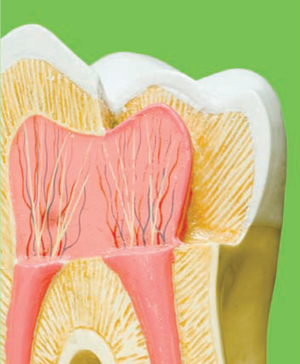Root Canal
What is a root canal?
 Underneath your tooth’s outer enamel and within the dentin is an area of soft tissue called the pulp tissue. While a tooth’s pulp tissue does contain nerve fibers, it is also composed of arteries, veins, lymph vessels, and connective tissue. Each tooth’s nerve enters the tooth at the very tip of its roots. From there, the nerve runs through the center of the root in small “root canals,” which join up with the tooth’s pulp chamber.
Underneath your tooth’s outer enamel and within the dentin is an area of soft tissue called the pulp tissue. While a tooth’s pulp tissue does contain nerve fibers, it is also composed of arteries, veins, lymph vessels, and connective tissue. Each tooth’s nerve enters the tooth at the very tip of its roots. From there, the nerve runs through the center of the root in small “root canals,” which join up with the tooth’s pulp chamber.
Why do I feel pain?
When the pulp becomes infected or inflamed due to a deep cavity or fracture, the blood supply to the tooth may be lost and the tooth pulp may die. Damaged or dead pulp causes increased blood flow and activity in the tooth’s cells. Pressure may build within a tooth that cannot be relieved, causing pain that is commonly felt when biting down, chewing, or consuming hot or cold foods and drinks.
Why might I need treatment?
Without treatment, the infection will spread and bone around the tooth will begin to degenerate, possibly causing the tooth to fall out. Pain usually worsens until you are forced to seek dental attention.
What is root canal therapy?
Root canal therapy is a procedure that removes the damaged or dead pulp. The canal is reshaped and filled with gutta percha, a rubber-like material, to prevent re-contamination of the tooth. The tooth is then permanently sealed.
What is involved in root canal therapy?
If your general dentist recommends a root canal, he or she will perform the treatment or refer you for treatment to an endodontist, which is a specialist who treats injuries, diseases, and infections of the tooth pulp. A space is created into the tooth’s pulp chamber, which, along with any infected root canal, is cleaned of all diseased pulp and reshaped. Medication may be inserted into the area to fight bacteria. Depending on the condition of the tooth, the crown may then be sealed temporarily to guard against re-contamination or the dentist may immediately fill the canals. Temporary fillings are usually removed and the pulp chamber and canals are filled on the next visit. If the tooth is still weak, a post may be inserted above the canal filling to help rebuild the tooth. Once filled, the area is permanently sealed. Finally, a gold or porcelain crown is normally placed over the tooth to strengthen its structure and improve its appearance.
How will I feel after treatment?
There may be some inflammation around the gum tissues, which may cause discomfort for a few days. This can be controlled by an over-the-counter pain reliever. A follow-up visit to your dentist will help him or her review how the tissue is healing. From this point on, brush and floss regularly, avoid chewing hard foods on the treated tooth, and see your dentist on a regular basis for cleanings and examinations.
Are there options to root canal therapy?
The only alternative to root canal therapy is to extract the tooth; however, this alone can cause the surrounding teeth to move, resulting in a bad bite. Though a simple extraction may be perceived as less expensive, the empty space left behind will require an implant or a bridge, which ultimately can be more costly than root canal therapy.

